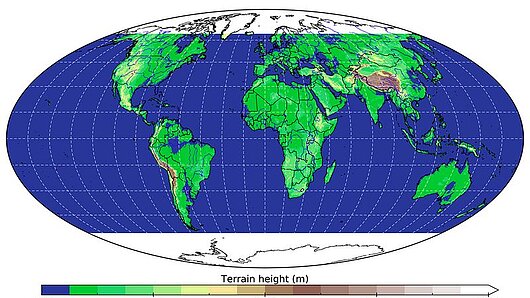High-Performance Computing Center Stuttgart

Understanding an area’s climate is not just predicting the weather. In fact, weather and climate are often used interchangeably, but have significantly different meanings—weather is the temperature, precipitation, and wind speed (among other factors) occurring at a specific place and time. Climate refers to general weather patterns and trends over a longer time period (most researchers consider anything longer than 30-year statistics representative of an area’s climate).
As part of studying both weather and climate computationally, the University of Hohenheim researchers are part of an international consortium of research teams developing and improving the Weather Research and Forecasting Model (WRF), one of the most well-regarded and well-developed numerical atmospheric circulation models in the world.
Even with leading HPC resources, many computational climate researchers run simulations at relatively low—or coarse—resolution in order to perform simulations over a large area and an extended period of time. Due to computational constraints, many large-scale international climate consortiums’ simulations apply a computational grid of 12 by 12 kilometer boxes or coarser over a limited area.
The finer the grid that researchers use, the more details they see in their simulations. Further, the more input details they include, such as sophisticated cloud microphysics, proper representation of the land surface, aerosols in the atmosphere, and more precise sea surface temperatures, the more accurate a simulation becomes.
This higher resolution and increased amount of detail makes computation much more time-consuming, though. To address this problem, researchers use regional atmospheric models such as WRF to focus more on a region of interest, such as a specific continent, while also including data representing the entire planet's atmosphere.
Hohenheim researchers including Dr. Thomas Schwitalla are working to improve seasonal weather forecasting by comparing a high-resolution WRF model simulation to global meteorological analysis data and other high-resolution observations from the same period of time. Schwitalla indicated that by focusing on one season, he can verify a model’s ability to forecast weather in a region during this period in statistical terms. In turn, this can help improve its predictive skills for future adverse weather events like droughts or heat waves.
In his most recent work, Schwitalla performed a simulation across the entire globe (minus the ice caps) from February to June 2015 at ultra-high resolution—3 kilometer by 3 kilometer squares (so-called “convection-permitting” resolution). This is extremely computationally expensive, but allows researchers to observe their model’s ability to model weather and climate at a level that more closely corresponds to the actual needs of communities and researchers.
Schwitalla hopes that he can gain access to the entire Hazel Hen machine and its successor system in order to attempt another major leap forward in the team’s climate research. He and his group hope to run an ensemble of seasonal simulations, gradually increasing resolution to 1 kilometer in the future. This would allow the team to assess forecast uncertainty and create a better representation of physical processes.
In addition to relatively small spans of time at ultra-high resolution, Hohenheim researchers also use HLRS resources to anticipate larger-scale climate trends far into the future.
In one of these projects, ReKliEs-De, Drs. Kirsten Warrach-Sagi and Viktoria Mohr spent much of the last three years working with a consortium of other climate scientists to model the Earth’s climate past, present, and future over the span of 140 years. This German Federal Ministry of Education and Research (BMBF)-funded national effort—an initiative contributing to a large set of European simulation promoted by the Intergovernmental Panel on Climate Change (IPCC)—focused on refining global climate models to be more accurate on a continental level.
To this end, Warrach-Sagi and collaborators used 97 million core hours on Hazel Hen, generating 2 petabytes—more than 2 million gigabytes—of data during their simulation. The team used 5,400 cores per run, and ran 4 runs in parallel. The team modeled climate patterns from 1958 to the year 2100, simulating climate in 1-minute timesteps, and exporting data for every three hours of simulated time.
The team found that if the Earth were to warm by an average temperature of 4°C over the next century—a number many models point to as plausible if the greenhouse gas emissions are not reduced following standards such as those in the Paris Agreement of 2015—Southwestern Germany’s summers would become hotter and drier, and the winters warmer and wetter (a potentially terrible result for German winter crop production), while Northeastern Germany would be more humid than it is today.
The team has the important task of providing datasets that are hosted on the Earth System Grid Federation (ESGF) website, meaning its massive volume of data has to be stored somewhere. Warrach-Sagi indicated that the team spends much of its time moving data on and off resources for analysis, transferring data to store longer term, and sifting through information to see what is most valuable for other researchers (the team’s datasets are hosted on the ESGF website so that other researchers involved in climate science can apply this data for impact studies related agriculture, forestry or hydrology, among other areas.
As computing power grows, Warrach-Sagi feels confident that climate scientists can not only model climate changes in higher resolution, but also focus on a broader, multidisciplinary approach to modelling, in turn helping to make better predictions about the effect of climate change on other aspects of human activity. She indicated that she is beginning to increasingly study land use effects in WRF, and would like to begin running crop models with these simulations in the near future.
—Eric Gedenk